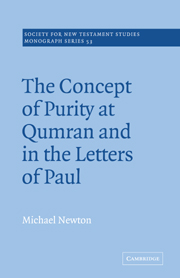Book contents
- Frontmatter
- Contents
- Acknowledgements
- List of abbreviations
- 1 Introduction
- 2 The concept of purity in the Qumran community
- 3 Purity and the cult in the letters of Paul
- 4 Purity and membership of the Church
- 5 Purity and the continuing life of the Church
- 6 Conclusion
- Notes
- Bibliography
- Index of passages cited
- General index
5 - Purity and the continuing life of the Church
Published online by Cambridge University Press: 10 December 2009
- Frontmatter
- Contents
- Acknowledgements
- List of abbreviations
- 1 Introduction
- 2 The concept of purity in the Qumran community
- 3 Purity and the cult in the letters of Paul
- 4 Purity and membership of the Church
- 5 Purity and the continuing life of the Church
- 6 Conclusion
- Notes
- Bibliography
- Index of passages cited
- General index
Summary
So far we have concerned ourselves with the concept of purity as it pertains to the ideology of the Temple. Purity, however, was a concern of observant Jews beyond the confines of the Temple. We have already noted how the Pharisees, early in the first century, were extending the purity regulations to the home. We now need to examine to what extent Paul applied the concept of purity, as he would have understood it as a Jew, to the continuing life of the Church.
Table fellowship and the purity of food
It is clear from what Paul says in 1 Corinthians 5:11 that believers are not to share their food with one of their number who is guilty of immorality, greed, idolatry, reviling, drunkenness or robbery. This, we have argued, is because of the impurity that such a person would have brought to the community, a point that is primarily based on Paul's view that the Church, as God's Temple, in which the spirit dwells, is holy (1 Cor. 6:17) and as such cannot be allowed to have its sanctity tainted.
It is tempting, in view of this attitude towards table fellowship, to make some comparison of the Christian fellowship of believers with the Jewish ḥavurot whose members kept the laws of purity and refused table fellowship to those whom they considered unreliable in regard to purity and tithing.
- Type
- Chapter
- Information
- The Concept of Purity at Qumran and in the Letters of Paul , pp. 98 - 114Publisher: Cambridge University PressPrint publication year: 1985



